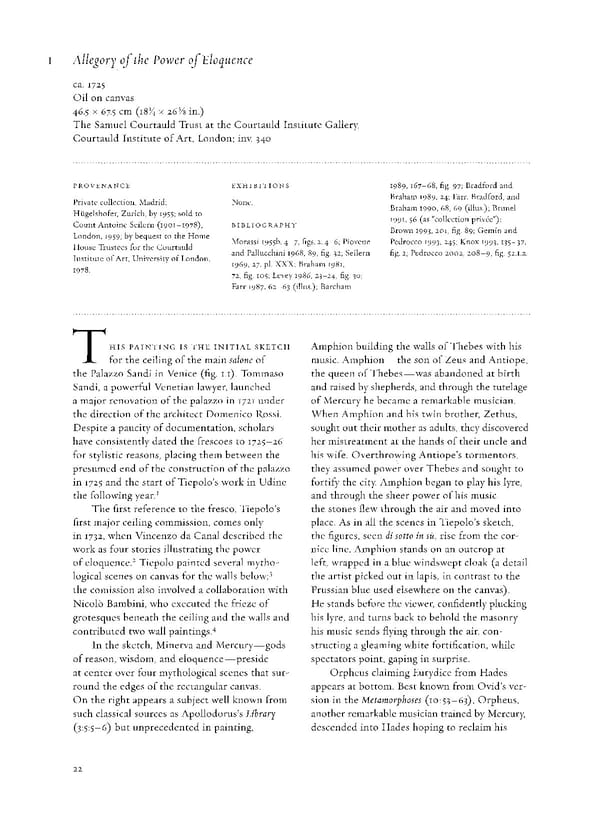I Allegory of the Power of Eloquence ca. 1725 Oil on canvas 5 46.5 x 67.5 cm (18% x 26 /s in.) The Samuel Courtaulct Trust at the Courtauld Institute Gallery, Courtauld Institute of Art, London; inv. 340 PROVENANCE EXHIBITIONS 1989, 167-68, fig. 97; Bradford and Private collection, Madrid; None. Braham 1989, 24; Farr, Bradford, and Hiigelshofer, Zurich, by 1955; sold to Braham 1990, 68, 69 (illus.); Brunei Count Antoine Seilern (1901-1978), BIBLIOGRAPHY 1991, $6 (as "collection privee"); London, 1959; by bequest to the Home Brown 1993, 201, fig. 89; Gemin and House Trustees for the Courtauld Morassi I955b, 4—7, figs. 2, 4—6; Piovene Pedrocco 1993, 245; Knox 1993, 135-37, Institute of Art, University of London, and Pallucchini 1968, 89, fig. 32; Seilern fig. 2; Pedrocco 2002, 208-9, fig- 52.1.a. 1978. 1969, 27, pi. XXX; Braham 1981, 72, fig. 105; Levey 1986, 23-24, fig. 30; Farr 1987, 62^63 (illus.); Barcham THIS PAINTING IS THE INITIAL SKETCH Amphion building the walls of Thebes with his for the ceiling of the main salone of music. Amphion—the son of Zeus and Antiope, the Palazzo Sandi in Venice (fig. i.i). Tommaso the queen of Thebes—was abandoned at birth Sandi, a powerful Venetian lawyer, launched and raised by shepherds, and through the tutelage a major renovation of the palazzo in 1721 under of Mercury he became a remarkable musician. the direction of the architect Domenico Rossi. When Amphion and his twin brother, Zethus, Despite a paucity of documentation, scholars sought out their mother as adults, they discovered have consistently dated the frescoes to 1725-26 her mistreatment at the hands of their uncle and for stylistic reasons, placing them between the his wife. Overthrowing Antiope's tormentors, presumed end of the construction of the palazzo they assumed power over Thebes and sought to in 1725 and the start of Tiepolo's work in Udine fortify the city. Amphion began to play his lyre, the following year.1 and through the sheer power of his music The first reference to the fresco, Tiepolo's the stones flew through the air and moved into first major ceiling commission, comes only place. As in all the scenes in Tiepolo's sketch, in 1732, when Vincenzo da Canal described the the figures, seen di sotto in su, rise from the cor- work as four stories illustrating the power nice line. Amphion stands on an outcrop at 2 of eloquence. Tiepolo painted several mytho- left, wrapped in a blue windswept cloak (a detail logical scenes on canvas for the walls below;3 the artist picked out in lapis, in contrast to the the comission also involved a collaboration with Prussian blue used elsewhere on the canvas). Nicolo Bambini, who executed the frieze of He stands before the viewer, confidently plucking grotesques beneath the ceiling and the walls and his lyre, and turns back to behold the masonry contributed two wall paintings.4 his music sends flying through the air, con- In the sketch, Minerva and Mercury—gods structing a gleaming white fortification, while of reason, wisdom, and eloquence—preside spectators point, gaping in surprise. at center over four mythological scenes that sur- Orpheus claiming Eurydice from Hades round the edges of the rectangular canvas. appears at bottom. Best known from Ovid's ver- On the right appears a subject well known from sion in the Metamorphoses (10:53-63), Orpheus, such classical sources as Apollodorus's Library another remarkable musician trained by Mercury, (3:5:5-6) but unprecedented in painting, descended into Hades hoping to reclaim his 22
 Giambattista Tiepolo: Fifteen Oil Sketches Page 22 Page 24
Giambattista Tiepolo: Fifteen Oil Sketches Page 22 Page 24